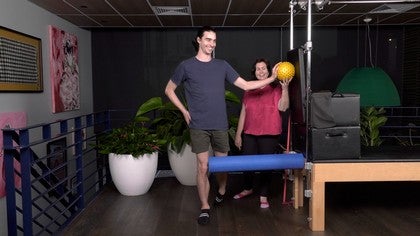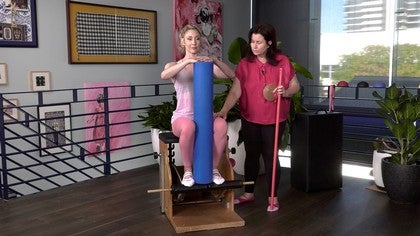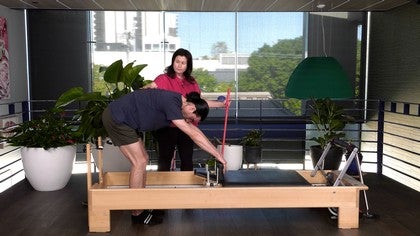Description
About This Video
Transcript
Read Full Transcript
(bright music) Hello and welcome to "Wishing you well". Today we're working on the reformer and the main purpose of this exercise series is on strengthening your deep longitudinal sling. In other words, your back line. The reason being is that when we are stressed or unwell we can sometimes lose our ability to activate the back muscles. We end up in too much flexion and therefore ending up that little position.
So wishing you well, this series requires us mainly to stay in the back well of the reformer, but there's a little bit of a setup. I have put on here, the cuffs. So these Velcros cuffs that you get with your reformers or with your trapes and I've slipped them on. If you don't have the cuffs you can take your normal loops and you can slip that through and we can attach your springs to here, okay. Now, if you find this too strong to use springs for some of this work you can use long Therabands, okay.
So the setup is going to be have your loops on, take very long light springs and I'm just going to clip them in and we'll leave them in there for now. And I'm going to leave this on one red spring or one medium spring. I would suggest for some people you may want to start on one blue or one light, like a blue or a yellow. That's just up to you. And the other props that I have are this is not compulsory.
You may need to use something like this to help you, if you have ankle restrictions. So I will tell you when you would use this if you don't have ankle restrictions, that's fine. I'm gonna delete the stick, just to push and prod at times. Our repetitions will be 10 and we are going at a slow deliberative pace. Our first point is Josh is going to be just a little bit back.
You may be closer if you're not as tall as Josh and we are going to start with a slight softening of your knees, pressing the big toe into the floor and a sense of relaxation into your heels. You're now going to just take the time to roll down. Taking the time to feel the femurs are rolling in that little bit, allowing yourself to get this opening for your sacrum. You're just going to just do one or two of these. Just to warm up the spine and also to test.
Remember to always have a test exercise to start and end your session. One more rolling down. Taking the time. This time, Josh, when you roll on, I'm going to take your hands and put them on the shoulder rest, okay? Now, for some people, it will be more comfortable to have your hands on top, others will be on the side.
You can choose, Josh where it feels more comfortable. What we're going to do from here is you are going to start to roll and pull the carriage towards you. Taking the control. This is the point where you discover whether one red or one blue is appropriate for you. And this time Josh, you're going to just roll forward just a little bit and come to a flat back.
Do not lose the tension on the spring. Start to roll. Feel the femurs rolling in pressing into your big toe, allowing your spine to come into a nice curl. Start to allow the carriage to draw you back out and just come to a flat back. Rolling back.
Just get that nice little stretch. Now, this time when you do this, take the time to remember. As you roll up, allow your ileums to open and feel the sacrum getting width in the socket. Staying there, keep the carriage pulled and feel like you are lifting your chest up. And you're arching your spine.
Nice. Feel that you bend your elbows just a little bit. Keeping the tension on the carriage, curling forward and back. It's just a fancy cat cow. And roll the femurs in to allow your flexion of your spine. Then for the extension, fill the femoral heads to spiral out just a little bit, to free up the sacrum and come into your extension.
Two more please, Josh and back and out. On your last one, we're going to curl. And this time as you arch your spine, you're going to let the carriage pull you forward, lifting through, lifting your chest up. Nice, coming up into the arch and reversing the direction, curling as you go back out. Nice little wave, allowing your spine one way arch and one way curl, allowing your spine to work in both directions, flexion and extension.
Two more. And slowly allowing your spine to lift. Lift your heart and here at this point, you may also bend your elbows. Just that little bit, bending them down more, more more getting almost like you're getting a nice little pushup. Josh is not thinking that's nice.
From there what you're going to do is bend the knees more and we are coming into a nice squat. Come down, deep squat. If at this point you are not able to squat down this far because of ankle restriction. This is when you would put something like this underneath your heels to give you a little bit more range, okay? So Josh feel like you pull the carriage towards you.
Let the carriage go back. We're going to do just five little deep squats. And at this nice pace, about three to four seconds coming in and out this time Josh, you're going to come up halfway. You're rolling up. That's fine, this is when you find out how your quads are working and we're going to stay in a half squat, work on building our quad strength.
Let's bring the elbows back and forward. Having that sense of lifting. The heart up just that little bit, Josh and back. We're going to do five with your feet down. If you feel that you can do this I would like you now to do five with lifting your heels up, keep your heels up and do the pulses.
If this is too much, slip the domes underneath your heels so you can support. You can lower your heels in between each exercise or you can just keep your feet flat. This is your choice. Nice work. Stay there.
Hold the carriage, smile. Remember you're enjoying yourself and see if you can now lower your heels down. Take your hips up, curl your spine and now allow the carriage to go back. Nice. You can now let the carriage just park for a moment please, Josh. And you can take your arms behind you and put them on the rises.
Or if you don't have rises on your reformer just put them on the edge of the reformer. We're in a nice little tendon stretch. Give yourself a nice stretch. Josh, maybe bend your knees just that little bit. And then curl back up and roll.
Take the time here to really enjoy this little moment of breath and lift your heels. Nice, beautiful way to prepare somebody for tendon stretch and lower your heels down. Lift your chest up. Get a nice stretch through the back of your shoulders through your hamstrings, curl back and down. We're just going to do two more like this.
If you would like you can do 10, but I think two to three of this one is just appropriate. Just enjoy that nice little stretch there. Just take the time, lower your heels down. Lift your chest up. What I like about this one is that you can add this in as a way of just giving yourself a bit of a break because the last part was building up a bit of a sweat, okay.
And also nice to open out the ribcage and get better breath. Okay and then lower. And then Josh, what we're going to do is as you come up to standing now, I'd like you to step forward and we're going to slip into the bathtub. Okay, so oo, rush there. Okay, so if you don't have the hamstring strength for this, put a little box underneath your bottom or a pillow, okay.
You will know by this stage if you don't have the hamstring strength. What you are going to do, Josh is I'm going to lean forward and put your hands on the shoulder rest. So this is a bit of a slump test. If this is too much for you, bring yourself up higher. Josh, I'm going to let you just let your head relax, roll the femurs in just a little bit and curl back.
So we're doing spine stretch. Cool, and lift and curl back. Feel the femurs role to facilitate the curl. Remember you can place your hands on top on the side. And for some people on the metal rises is more comfortable.
Work out what works for you. Curl back and forward. We will do 10. How many is that Josh? It's my sixth.
I always love it. You ask a client. Yeah. I always love it. You ask a client how many they've done a type of six or seven because they know they haven't got that much more to go. Oh, nine.
Nine. You know, they're lying. And one final one we'll make this 10 this time on your 10th one what you're going to do is stay there straighten your back up and pull the cart back straight. Nice. Keeping your back straight now, you're just going to let the carriage go forward and back just 10 times, get some nice work on the triceps. And helping you strengthen through that posterior sling. Remember if it's easier for you put your hands on the metal runs.
This isn't about making you suffer. Well, it is but we can be kind as well. Eight. Numerous clients are always a delight. So we've done our flat back.
Let's add a bit of a twist. So what Josh is going to do is take his hand. You can either put it on here or here. It depends what works for you, okay. And what you're going to do is as you pull back, we're going to sashay.
So that means as he pulls to this side, he's going to take the opposite leg away. One femur draws in, one femur draws out. Facilitate the movement of the spine from the way the femurs are moving in the hip sockets. We're going to get that nice bit of twist and just that little bit of movement in the sacrum and the lumbar spine. Remember to grow tall as you pull back and control the carriage as you move away.
And once you've done 10 you'll change sides. This is always the hard bit. And remember, as you twist to one side the opposite femur is sliding out. Get those obliques working, pull and back, allow yourself to grow tall and lengthen up out of your spine as you rotate to the side. Eventually a nice little variation from this would be to take the top hand and put that behind your head and move from there.
Adds a little bit of a lever, a little bit more fun. We all want that. Build that upper body strength. Remember though, for some clients it's maybe too much for grip so you can always just bring it to where it feels comfortable for your grip. Is that 10 Josh?
Have fun. Nice. So just take a moment. What we're going to do is we are going to take your springs and we're going to slip them into your hands. Remember, you can just use a Theraband if you want. And from there, Josh is going to start with his hands out to the side and he's going to scoop the humeral head in and bring the arms up.
Take the elbows down and scoop to the side. So I'd like to think of this as hug-a-tree with a little bit of a different pull, nice. Build the strength, feel the work of the humoral head, gliding, rotating and then coming into your biceps. We can do two exercises at once you know and this is strong. So please, if this is too much for you, go back to a Theraband, no shame.
Josh will tell you when we practice this he was sore the next day and back. A good sore. A work sore. Lovely and there, 10? And now Josh, you're going to move forward just a little bit.
So we're going to take a little bit of tension off the spring and you're going to slip back onto your elbows, okay. What you're going to do from there is put your hands behind your head. So this is about working the posterior part of your shoulder blades. Okay, so you're going to curl just a little bit, Josh and bring your elbows forward just a little bit. So curl, roll forward into your spine stretch, lift your chest up and take your arms back, open out in your chest.
Curl back. Nice work Josh, because I'm kind, we're just going to do five of this, okay? You can do 10 if you would like. On your fifth one, you're going to stay upright. One more, stay there Josh and there and stay on your fifth one.
You are going to just tilt to one side and tilt to the other side. Just get that lateral shift of your ribcage back and forward. Just five, each side. I used to use the reference of a typewriter. I find not many people understand what I'm talking about but it's the idea of the sliding of the ribs like you would see a typewriter carriage moving across.
Nice, this time, you're going to slide the rib across and rotate round. Again, we're just going to do five, lovely. Rotate up and back. So remember slide to the side, facilitate the movement of the zygapophyseal joints so that you can slide and get a little bit more rotation. You need to have that little bit of slide to facilitate rotation.
And this is a really nice way to achieve this. One more that side. I'm going to be kind, because this is probably very tiring at this point. And just one more this side, Josh and (indistinct). Good work.
Nice. Come out of there. I'm just going to take the springs off for a moment. We're not going to abandon them. We just put them down for a moment. Just take a moment.
Big breath. Come up to standing. Now take a big breath. Find where you are in your heels. Feel where you are, feel how your rib cage is moving and your torso is stronger.
Josh, what we're going to do now is I'm put the headrest back up so that you can put your heel in there. I like to use the stick just in case people need to hold on and balance there while I get this sorted for them. Josh, what you're going to do is put your hands in there. Use that as a little bit of a support for you. Okay, so what you are going to do soften the knee, don't lock into the joints, press your heel into the top of the headrest.
Use that to help you activate your hamstrings as you drag the foot back. Good, Josh. And what you're going to do now is as you roll the leg back, pull the hands back. And forward and roll. So we are going to work from pronation into supination of your forearm so that you can get just that nice sort of placement of the shoulder.
Remember very often when we are overworking the shoulder or have poor shoulder girdle organization, we can overwork in the forearm. Nice, once you've done 10, you can change legs. Or you can just to work yourself a little bit harder, come up onto your toes, okay. Up onto your toes and I'd only get you to do five of those. Sometimes when you're working with clients you might want to just do 10 like this, change legs and then come back and do the toes because they can be quite fatiguing.
Nice work and changing legs. Standing, pull the leg back and in taking the time to work slowly and carefully, as you drag the heel back to really get that hamstring working. Opposite glute should also be firing nicely. And I'd like to make sure that you can just get that femoral spiral to help you activate the glute. On your 10th one, raise your heel back and forward.
Nice, when you're ready, keep hold of the springs and take your leg down, okay. Just take the time. How's that feel? (indistinct) Feel a bit loose. Don't you, even though you worked hard or is it just because the exercise has ended?
So from there, what you are going to do is just come into a slight squat and take your arms back. Nice and forward. Just get that lovely squat that we did at the beginning. But now, instead of using the pressure of the cart, the pull, we're adding in a push. Nice work, Josh.
Take your time, work slowly and deliberately. Now, if you can stay there and just bend your elbows. And back, we're just going to do five little pats backwards. You may need to come forward a little bit if that's too strong. Nice work.
Lovely work, we'll take those out. Whew. Don't want to, do I? I told you you could do more if you like. And what you're going to do now, Josh is roll down. Put your hands on the edge of your carriage, press your hands into there and just do a nice cat cow, getting your spine working.
Nice and then roll up. Come up to standing, take a smile and a little bow. Thank you and enjoy.
The Teacher's Corner: Claiming Immunity
Comments
You need to be a subscriber to post a comment.
Please Log In or Create an Account to start your free trial.
















